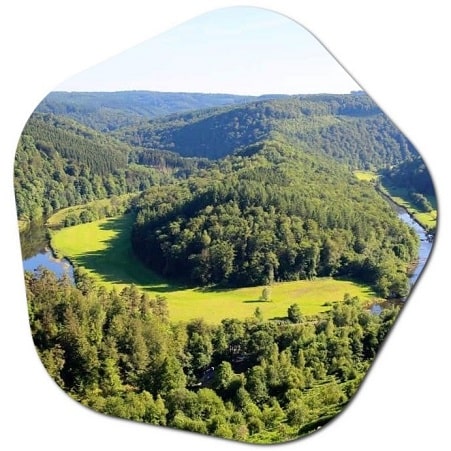Does Belgium get snow? Yes, Belgium does receive snowfall during the winter months, although the amount and frequency can vary from year to year. Snowfall is most common in the Ardennes region, which is located in the southeastern part of Belgium and has higher elevations. The Ardennes, with its hilly and forested landscapes, is more likely to experience colder temperatures and more significant snowfall compared to the flatter and coastal areas of the country.
In the rest of Belgium, particularly the central and northern regions, snowfall is less frequent and often less abundant. The coastal areas, in particular, tend to experience milder winters and receive less snowfall due to the moderating influence of the North Sea.
When snowfall does occur, it can create picturesque landscapes and provide opportunities for winter activities such as skiing, snowboarding, and sledding, especially in the Ardennes region. However, it’s important to note that the snow cover in Belgium is typically not as extensive or long-lasting as in more continental or mountainous regions.

The Belgian climate is characterized by several important features:
- Maritime Influence: Belgium has a maritime climate due to its proximity to the North Sea. The sea plays a significant role in moderating temperatures and influencing weather patterns. The maritime influence brings relatively mild winters and cool summers compared to more continental climates.
- Mild Winters: Winters in Belgium are generally mild, with average temperatures ranging from 0°C to 6°C (32°F to 43°F) in January, the coldest month. Snowfall is common but tends to be limited and often melts quickly.
- Cool Summers: Summers in Belgium are relatively cool, with average temperatures ranging from 12°C to 23°C (54°F to 73°F) in July, the warmest month. While temperatures can occasionally reach higher levels, prolonged periods of extreme heat are rare.
- High Precipitation: Belgium receives a significant amount of rainfall throughout the year, with no distinct dry season. Precipitation is relatively evenly distributed, although the coastal areas tend to be slightly wetter than the inland regions. Rainfall supports the country’s lush vegetation and agricultural productivity.
- Cloudy and Changeable Weather: Belgium experiences a fair amount of cloud cover throughout the year, which contributes to the cool and temperate climate. Weather conditions can change rapidly, with alternating periods of sunshine and showers.
- Moderate Sunshine: Belgium has a moderate amount of sunshine, with an average of around 1,500 hours of sunshine per year. Summers tend to have more sunshine than winters, but cloudy conditions are common.
- Coastal Winds: The coastal regions of Belgium experience the influence of sea breezes, which can bring cooler temperatures and higher humidity. The coastal areas also tend to be windier compared to inland regions.
It’s important to note that while these are general characteristics of the Belgian climate, there can be regional variations within the country. Local geography, elevation, and proximity to bodies of water can influence microclimates and result in some deviations from the overall patterns.
Does Belgium have 4 seasons?
Yes, Belgium experiences four distinct seasons: spring, summer, autumn (fall), and winter. Each season brings its own characteristic weather patterns, temperature ranges, and natural phenomena. Here’s a brief overview of the four seasons in Belgium:
- Spring (March to May): Spring in Belgium is characterized by gradually rising temperatures and longer daylight hours. It is a transition period from the colder winter months to the warmer summer season. Spring in Belgium can be variable, with periods of rain and occasional fluctuations in temperature. During spring, plants and flowers start to bloom, and the countryside becomes vibrant with fresh greenery.
- Summer (June to August): Summers in Belgium are generally mild to warm, with average temperatures ranging from 12°C to 23°C (54°F to 73°F). While Belgium does not experience extremely hot summers compared to some other regions, occasional heatwaves can occur, with temperatures reaching higher levels. Summers are typically the driest period in Belgium, with longer periods of sunshine and less rainfall.
- Autumn (September to November): Autumn in Belgium is characterized by cooler temperatures and the changing colors of the foliage. The weather becomes more variable, with a mix of sunny and rainy days. Average temperatures range from 6°C to 17°C (43°F to 63°F) in autumn. It is a season of harvest, and the countryside displays beautiful shades of red, orange, and yellow as leaves change before falling.
- Winter (December to February): Winters in Belgium are generally mild, with average temperatures ranging from 0°C to 6°C (32°F to 43°F). While snowfall is not as frequent or abundant compared to some other European countries, Belgium does experience occasional snow during winter, particularly in the Ardennes region. Winters can be damp and cloudy, with shorter daylight hours.
These four seasons contribute to the natural diversity and the changing landscapes of Belgium throughout the year. The distinct seasonal changes also influence agricultural activities, outdoor recreation, and cultural traditions in the country.
How cold is Belgium in winter?
In winter, Belgium experiences relatively mild temperatures compared to some other European countries. The exact temperatures can vary from year to year and may differ between different regions within Belgium. However, on average, temperatures during the winter months in Belgium range from 0°C to 6°C (32°F to 43°F).

In the coldest months of December, January, and February, temperatures often hover around freezing or slightly above freezing. It is not uncommon for nighttime temperatures to drop below freezing, especially in inland and rural areas. The coldest regions of Belgium tend to be the Ardennes, located in the southeastern part of the country, where higher elevations contribute to colder temperatures and increased chances of snowfall.
While winter temperatures in Belgium can be chilly, prolonged periods of extreme cold are rare. The country’s maritime climate, influenced by the nearby North Sea, helps to moderate temperatures and prevent excessively cold conditions. It’s important to note that weather patterns can vary, and occasional cold snaps or short periods of colder weather can occur, particularly when Arctic air masses push southward.
It’s always a good idea to check local weather forecasts and dress appropriately for the winter conditions when visiting or living in Belgium during the colder months. Climate in Belgium >>
